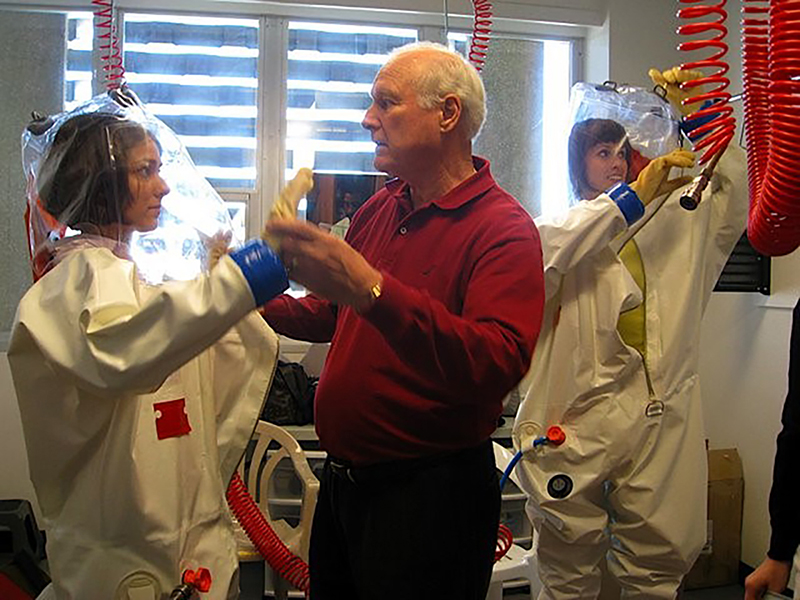SORT at 20

In late January 2016, the Centers for Disease Control and Prevention (CDC) called on their Emergency Operations Center (EOC) to address the rising cases of birth defects due to the Zika virus.
In response to the call to staff up the center, a member of the resource support section immediately said, “Can’t we SORT this?”
The CDC staffer was referring to the Rollins Student Outbreak and Response Team, a student-run organization that provides trained and committed volunteers to aid county, state, and CDC response efforts. Now in its 20th year, SORT has lent much-needed assistance in outbreaks and emergencies including the H1N1 epidemic, Hurricane Katrina, the Ebola outbreak, and the COVID-19 pandemic.
When Emory made flu vaccines mandatory, SORT arranged two flu clinics at Rollins for students to get their shots. 
“I am the academic advisor for SORT,” says Dr. Allison Chamberlain, director of the Emory Center for Public Health Preparedness and Research. “But truly, I meet with the new presidents every year to welcome them, reiterate the organization’s mission, and let them know I am a resource and advocate for them. The students run the show. They don’t need a faculty member to make introductions for them anymore. They are known by their own reputation and name.”
Dr. Ian Williams puts it another way. “The fact that SORT has become a verb at the CDC tells you all you need to know about how valuable and effective it is,” says Williams, the deputy director for the agency’s Center for Preparedness and Response.
A TEAM IS LAUNCHED
The idea for SORT originated over two decades ago in the DeKalb County Board of Health (DCBOH). “We saw SORT both as a way to expose students to the complexities of real-world public health practice at the local level and as a way for us to have extra hands on deck in the event of an emergency,” says Sara Forsting 01MSPH, who was working as an epidemiologist with the DCBOH at the time.
Forsting found a receptive partner at the Center for Public Health Preparedness and Research, which was established after 9/11 with a gift from the O. Wayne Rollins Foundation. “It was immediately clear that this was going to be a great opportunity for our students,” says Dr. Ruth Berkelman, professor emeritus who led the center and served as the SORT faculty advisor until she retired in 2018. “I supported them, but it’s the students who get the credit. It’s amazing what the first groups of SORT students took on and the structure they established.”
SORT is intentionally a small, competitive group, admitting only a fraction of the interested students who apply. Students must apply for admission and commit to attending meetings, volunteer events, trainings, and selected classes. “Many more students apply than get in,” says Berkelman. “Only the ones we think are the most committed make it.”
In the early years, SORT worked exclusively with the DCBOH, where students received training in preparedness and public health infrastructure, participated in tabletop to full-scale response exercises, and stepped in to help when the real thing hit. “I remember SORT students helping us with a large TB outbreak in a DeKalb County school, several foodborne outbreaks, and the West Nile virus,” says Ariane Reeves 07MPH, who helped establish SORT when she worked as a nurse epidemiologist at the DCBOH.

Amy Moskovitz, left, and other SORT students received BSL 4 laboratory training.
TAKING IT TO A NEW LEVEL
In 2008, Shauna Mettee Zarecki 09MN/MPH and Amy (Williams) Moskovitz 09MPH took over as co-presidents and, according to Berkelman, took SORT to “a whole new level.” Under their leadership, membership became limited to 30 to advance their training and specialization. SORT members were trained by the Red Cross to be certified disaster volunteers, and they were required to complete basic FEMA incident management and CDC EOC 101 trainings. In addition, many optional educational opportunities were offered, such as laboratory biosafety training and visiting a mock BSL 4 laboratory. They re-established the Steering Committee composed of local and federal public health stakeholders to maintain a vision across the years and to have an active role in SORT’s path to ensure it remained valuable and relevant.
Zarecki also established the group’s first ties with the CDC, which included getting CDC badges for all team members so trained SORT students could quickly respond if needed by CDC. Initially, SORT students worked with the foodborne outbreak division, which at the time was headed by Williams.
“It was important to us that SORT students would not be ‘response tourists,’ but rather true assets to the organizations they served,” says Zarecki. After graduating from Emory, Zarecki joined CDC’s Epidemic Intelligence Service in 2009 as a nurse in the US Public Health Service.
Dr. Ruth Link-Gelles 10MPH, now Lt. Commander in the US Public Health Service and a CDC epidemiologist, remembers manning the CDC Emergency Operations Center (EOC) when she was a SORT member. “With foodborne outbreaks, if you had 40 cases, you might need to contact two to three times that number of controls, or people who had eaten at the same place but did not become ill,” says Link-Gelles. “We’d have SORT members in the EOC at all hours of the day and night and on weekends to make sure we could reach people when they were home. Usually, our job was to call the cases and controls and do lengthy interviews to narrow down the exposure of interest for a given outbreak.”
EBOLA AND THE SUPERBOWL
When H1N1 hit in 2009, SORT members moved beyond foodborne outbreaks to help with the response. Since then it has responded to myriad outbreaks and emergencies, perhaps none as fearsome as the Ebola outbreak in 2014. As the hemorrhagic fever sped across West Africa, the CDC called an all-hands-on-deck, which included SORT.
All SORT members, numbering 45 at the time, were tasked with helping update sparse or nonexistent maps of remote African villages so troops on the ground, such as Doctors Without Borders, could find and respond to localized outbreaks.
“The CDC trained all of us in using an open street mapping platform to examine satellite imagery on a very granular level, zooming in on a small section and identifying what we thought were houses, roads, ponds, etc.,” says Anna Tate 15MPH, who was communications chair of SORT at the time. “Once we tagged something, it was uploaded in real time. We all took this very seriously and spent hours and hours working on it. We were honored to be able to play a part in the response.”
In 2019, when the Super Bowl was coming to Atlanta, the Fulton County Board of Health (FCBOH) decided it needed to revitalize its medical reserve corps (MRC), which had been inactive for several years. MRCs were established after 9/11 to train and vet banks of volunteers who could be called up in the event of emergencies.
“The emergency preparedness team in Fulton County was seven people,” says Wendy Smith, then emergency preparedness administrator for the FCBOH. “About 500,000 people were going to be attending the Super Bowl. We needed to revitalize our MRC unit in the event of an emergency.”
SORT played an active role in that revitalization. SORT leaders were given two positions on the steering committee, which involved brainstorming on what the MRC unit should look like and how it should function. They helped with communication, volunteer recruitment, volunteer training, and management plans.
When the Super Bowl arrived, SORT leaders worked in the FCBOH EOC throughout its 10-day activation as liaisons for the volunteers. “And not just the SORT volunteers, but all the volunteers,” says Smith, who is now an emergency management specialist at the CDC. “I’m not sure how we would have done it without them.”
PANDEMIC RESPONSE
During the past two years, SORT, like almost every public health and health care organization, has focused nearly all of its efforts on responding to the COVID-19 pandemic. SORT members have worked with the DCBOH, FCBOH, CDC, and the Georgia Department of Public Health, helping with volunteer management and operations for testing and vaccination sites, including the massive effort at Mercedes-Benz Stadium. Paige Harton 21MPH, who was a SORT co-president in 2020, served as the COVID-19 SORT volunteer coordinator for the FCBOH.
SORT students are offered complete CPR training when they join the team.
At Emory, SORT members sat on the Rollins leadership COVID response committee, helped with contact tracing and case investigations, and coordinated a flu clinic.
“When Emory made the flu vaccine mandatory, we arranged to set up a flu clinic at Rollins so students could easily get their shots,” says Harton, who is pursuing a PhD in epidemiology at Rollins. “We provided 213 flu vaccines to students during the fall of 2020.”
POISED FOR THE FUTURE
The ability to meaningfully participate in responses like these is a powerful draw for prospective students. “I came to Rollins in large part because of SORT,” says Zarecki. “I was looking at several different schools, and SORT made a big difference.”
That allure is just as strong today as it was when Zarecki matriculated. Current SORT co-president Joel Espinoza MPH23 credits the organization with drawing him to Rollins. “SORT was a big reason I applied to Rollins in the first place,” he says. “I wanted to be president because I wanted to help shepherd it through the next year. I believe my experience with SORT will be a real professional leg up when I go to look for a job.”
And that’s exactly what many past SORT leaders have found. Zarecki is now a commander with the US Public Health Service in CDC’s Center for Preparedness and Response Situational Awareness Branch and has deployed more than 12 times for the COVID-19 response alone. Link-Gelles is the program lead for the CDC’s COVID-19 vaccine effectiveness team. Tate is an interdisciplinary scientist in the Office of Preparedness and Response at the US Department of Health and Human Services.
“I worked on the H1N1 outbreak when I was with SORT,” says Link-Gelles. “My first position at the CDC was in the bacterial respiratory disease branch, and I basically was able to get that position—fresh out of my MPH—because of the experience I gained through SORT.”
With such success stories, the student organization that was founded 20 years ago seems well positioned to last well into the future. “It means so much to me to see SORT so vigorous and strong and yet able to adapt to the public health priorities of the moment,” says Zarecki. “It is just amazing when people tell me that the reason they selected Emory for their public health degree was because of SORT, and it speaks to the quality of the SORT experience to see what SORT alumni have gone on to accomplish.”




